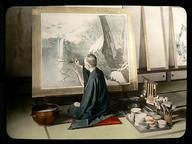Quiz Answer Key and Fun Facts
1. This is a type of illusionist painting wherein the artist attempts to extend the real architectural elements in a room by 'continuing' them along the walls or ceiling using elements of perspective and foreshortening...name it!
2. The Qilin is one of the three primary mystical creatures of Chinese mythology, along with the 'long' (dragon) and 'feng' (phoenix). With which creature of Western mythology is the Qilin typically likened?
3. True or false: The 15th century is referred to with the adjective 'Quattrocento' when discussing Italian Renaissance painting and sculpture.
4. A very eclectic style of architecture became popular in the United States during the last few decades of the 19th century. After which English Queen was this style named?
5. One of the key women of Chinese art and myth, she is called 'Xi Wang Mu', and is the guardian of the peach trees of immortality, which bear fruit once every three-thousand years. How is her name translated into English?
Source: Author
thejazzkickazz
This quiz was reviewed by our editing team before going online.
Any errors found in FunTrivia content are routinely corrected through our feedback system.
